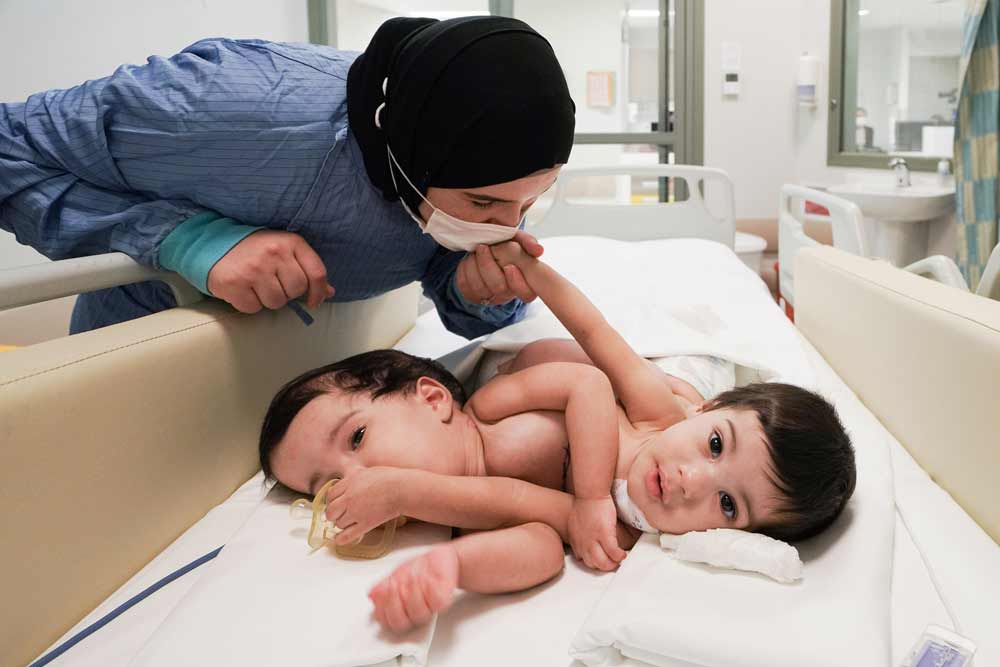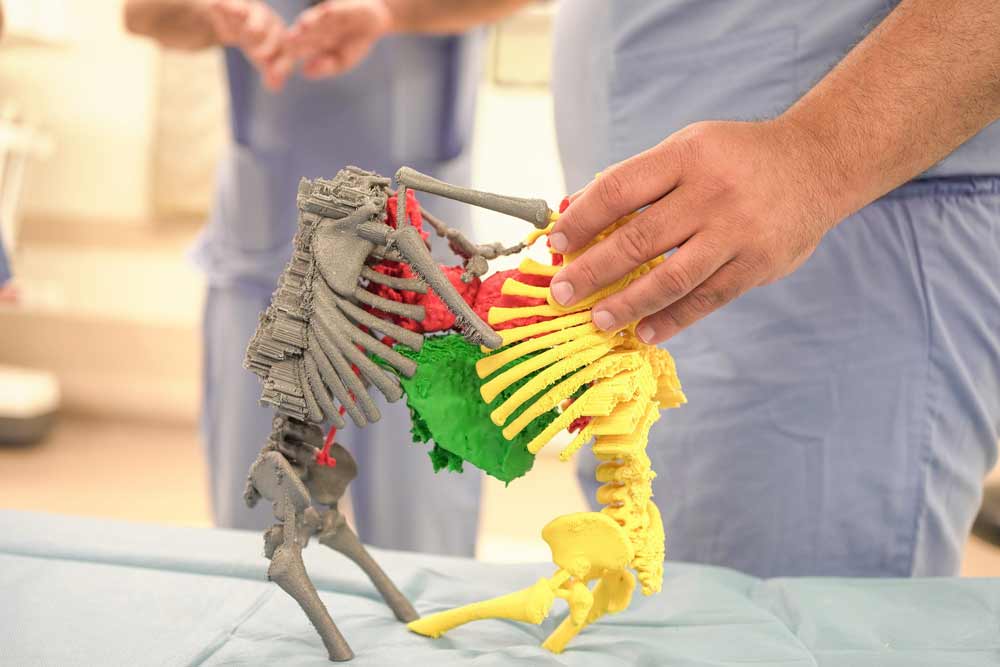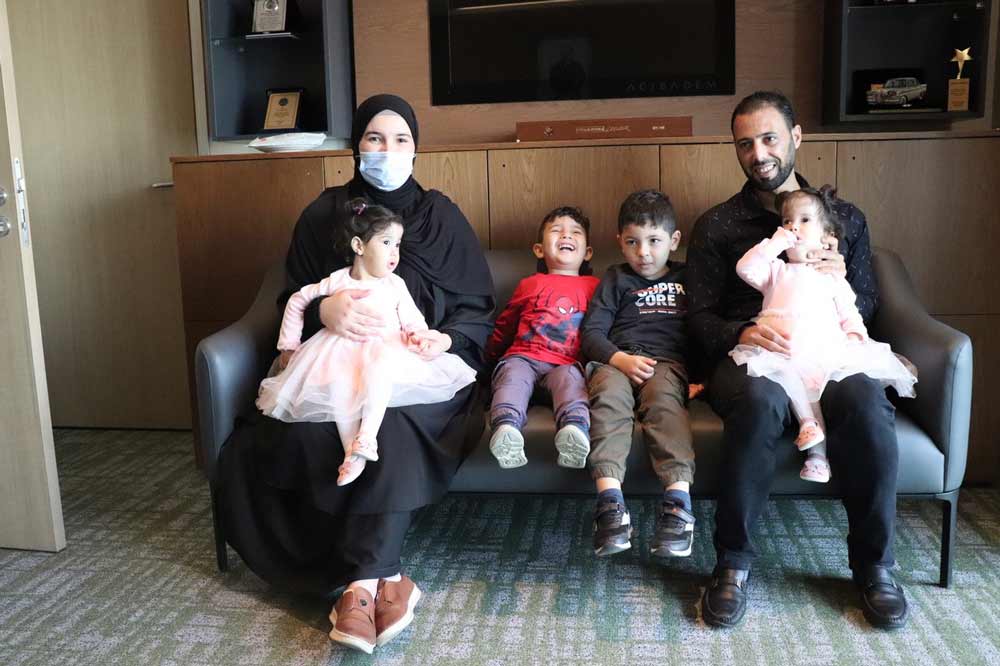Algerian Conjoined Twins Safaa and Chifaa, got their own bodies in TURKIYE
SIAM TWINS SUCCESSFULLY SEPARATED IN ACIBADEM HOSPITAL

Algerian conjoined twins Safaa and Chifaa have successfully undergone separation surgery in Turkiye, at Acibadem Hospital. The procedure resulted in each of them having their own individual bodies.
Safaa and Chifaa were 5-month-old conjoined twins when they were brought to Turkiye from Algeria. They were born facing each other, with their bodies joined from the front of the chest to the abdomen. Their pericardium and liver were fused together, and they were missing thorax and ribs. Additionally, Chifaa had hydrocephalus, which caused fluid to accumulate in her brain, leading to rapid head growth and worsening neurological development. While other countries offered to help separate the conjoined twins, they were entrusted to Turkish physicians at Acıbadem University Atakent Hospital in Istanbul on December 15, 2021, under the patronage of Algerian President Abdelmadjid Tebboune.

The separation process was undertaken by a team of around 100 medical professionals, including:
- Pediatric Surgeon Specialist Professor Burak Tander, M.D. and his team
- Pediatric Cardiovascular Surgery Specialist Professor Ersin Erek, M.D. and his team
- General Surgery Professor Remzi Emiroğlu, M.D. who is an expert in
the field of organ transplantation and his team - Plastic, Reconstructive and Aesthetic Surgery Specialist Professor Mehmet Veli Karaaltın, M.D. and his team
- Brain and Nerve Surgery Specialist Professor Kenan Koç, M.D. and his team
- Anesthesiologist Professor Tayfun Güler, M.D. and his team
- Pediatric Intensive Care Specialist Professor Agop Çıtak, M.D. and his team
- Pediatric Infectious Diseases Specialist Professor Metehan Özen, M.D.
- Radiology Specialist Professor Can Çalışkan, M.D.
- Pediatric Neurology Specialist Canan Kocaman, M.D.
- Pediatric Specialist Barış Yazar, M.D.
El-Alia Kherkhar, the mother, shared the shock of learning about the conjoined twins during her pregnancy and the emotional journey the family went through. She expressed her unwavering hope and faith that everything would turn out fine for her daughters. The Algerian community rallied behind the family, and the twins were eventually brought to Turkiye for the life-changing surgery.

A dedicated team of 100 healthcare professionals at Acıbadem University Atakent Hospital united their efforts for this intricate separation procedure. Upon their arrival on December 15, they tirelessly worked around the clock, operating as a unified force with remarkable synchronization, akin to the harmonious coordination of the five fingers on a single hand. Through numerous examinations and meticulous observations conducted by a cadre of physicians, a comprehensive 3D representation of the twins’ internal organ structure was meticulously crafted within a computer program. This digital model served as the foundation for preparatory simulations and virtual surgeries, where specialists meticulously addressed potential risks down to the most minute details, methodically shaping the surgery’s blueprint for optimal outcomes.
Chifaa faced a complex challenge due to advanced hydrocephalus, a condition characterized by fluid accumulation in the brain, resulting in head enlargement and neurological complications. Ahead of the separation surgery, the Brain and Nerve Surgery team expertly performed a shunt procedure to alleviate the fluid build-up and successfully curtail her hydrocephalus. This intervention proved pivotal in stabilizing her neurological well-being.

Furthermore, in anticipation of the anatomical void that would emerge upon separation, the medical team embarked on a process of skin expansion starting from February 2022. The objective was to generate sufficient skin tissue to cover the anticipated space on the anterior chest walls once the twins were separated. This arduous journey culminated on June 6, 2022, with a meticulously orchestrated 9-hour surgical procedure that successfully detached the conjoined twins from each other. Following the surgery, the twins remained under rigorous medical supervision within the hospital for an additional 4 months, receiving intensive post-operative care.
While the mother, El-Alia, states that they are happy with the long, grueling but successful treatment process for them, she also adds that conjoined twins may be born again in different countries of the world and their parents may experience different feelings like them. She gives the following advice to families with conjoined twins: “Families should keep their faith high, because Allah will definitely bring good doctors before them and help them.”
The father, Ibrahim Kherkhar, also says that: “Choosing the right hospital is very important. A facility like Acıbadem would have the right team and technology to handle such complicated cases. We received the right service in Acıbadem Atakent Hospital. That’s why we are so lucky. As parents, we have been very patient, we have had very difficult days psychologically. We waited for months for skin expansion, but nothing was in vain, now we are discharged with all the procedures done and the treatments completed, we are returning to our home. We would like to thank all our doctors who provided all kinds of support during this difficult process, all the hospital staff who were with us, Algerian President, who sent us to Turkiye and made it possible for our conjoined girls to separate from each other”. Expressing that they will celebrate 2 birthdays in the next period, the family says, “The day they were born and the day they were separated will be two seperate birthdays for us”.
Today, these once-conjoined twins stand as a testament to medical excellence, as they emerge from their challenging ordeal with their own individual bodies and restored health, ready to embark on a new chapter of their lives.
Acıbadem University Faculty Member and Acıbadem University Atakent Hospital Organ Transplantation Department Head and Liver Transplant Supervisor Professor Remzi Emiroğlu, M.D. says that: “Although the available literature offered limited insights, my confidence grew upon encountering success rates of up to 80 percent achieved by proficient and well-coordinated surgical teams. Our preparation was meticulous; a three-dimensional model served as the foundation of our work, enabling us to commit every anatomical intricacy to memory. Extensive efforts were invested in devising radiological strategies for the precise separation of vessels and bile ducts. Our paramount concern lay in ensuring an equitable division of the liver with no room for complications. Our team’s dexterity and seasoned proficiency assured a seamless process devoid of unexpected challenges. As anticipated, our aspiration to symmetrically partition the liver was realized triumphantly”.

Acıbadem University Pediatric Surgery Department Member and Acıbadem University Atakent Hospital Pediatric Surgery Specialist Professor Burak Tander, M.D. also says that: “In our pursuit of successfully parting the twins, who were admitted at just 5 months old, an extensive series of consultations unfolded with multidisciplinary teams hailing from various fields. The outcome was a meticulously crafted treatment blueprint. The trajectory encompassed several surgeries targeted at addressing Chifaa’s hydrocephalus. Leveraging a blend of specialized synthetic materials, exclusive organic tissues, and innovative constructs from Acıbadem laboratories, surgical interventions were deftly orchestrated. The objective? To fabricate connective tissues capable of sealing the substantial void poised to emerge post-separation. Upon culmination of the preparatory surgeries, which spanned approximately six months from their initial admission, the twins were unequivocally divided and subsequently tended to within the confines of our intensive care unit.”
Acıbadem University Atakent Hospital Neurosurgery Specialist Professor Kenan Koç, M.D. states that Chifaa has congenitally advanced hydrocephalus, therefore, fluid accumulates in her brain and her head is constantly growing and adds that: “Prior to the separation procedure, a time-sensitive intervention within the realm of Chifaa’s hydrocephalus was imperative, orchestrated by our neurosurgery team. This intervention was of paramount significance to prevent the loss of both infants. Our collaborative efforts as a team were characterized by unwavering dedication and meticulous attention to detail. A shunt surgery was executed, facilitating the drainage of accumulated cerebral fluid in Chifaa’s brain. Despite the arduous nature of the process, her condition has notably improved. The expansion of her cranial dimensions has been arrested, accompanied by a commendable enhancement in her neurological adaptability. Unified by a shared purpose, we efficaciously executed the separation, restoring each twin to their distinct physical identities while concurrently managing their ongoing treatment”.
Acıbadem University Faculty Member and Acıbadem University Atakent Hospital Pediatric Intensive Care Specialist Professor Agop Çıtak, M.D. summarized the intensive care process as follows: “We confronted a formidable challenge, marked by its complexity. Acknowledging the potential for grave complications both during and post-operation, we approached this task as a unified team, meticulously accounting for every conceivable scenario and eventuality. This rigorous preparation commenced well in advance, right from the moment the children were admitted to the intensive care unit in the immediate aftermath of the procedure. Without delay, Safaa and Chifaa were tethered to an array of monitors, a safeguard measure ensuring constant vigilance. The twins were diligently monitored under the watchful eye of ventilatory support. Gradually, the twins were weaned off the ventilator, each sister making this transition at a measured interval of a few days. This transition was particularly intricate for Chifaa, given her neurological condition, which necessitated a more protracted stay in the intensive care setting. However, our commitment paid off as we triumphantly transitioned both twins to their respective rooms, their well-being intact”.
Aesthetic, Plastic and Reconstructive Surgery Specialist Professor Mehmet Veli Karaaltın, M.D. also says that: “Through cohesive teamwork, we achieved the successful separation of the twins. The realm of plastic surgery witnessed several pioneering breakthroughs through our efforts. The exigency for innovative approaches arose due to the dearth of sufficient skin tissue to envelop the impending gap in the anterior chest wall post-separation. Prior to embarking on the skin augmentation procedure, we embarked on a meticulous trajectory by leveraging 3D technology. Precise calculations and surgical simulations were undertaken, ensuring meticulous planning. A groundbreaking achievement unfolded as we introduced vascularization to tissues through the application of the cell-free placental membrane, an innovation forged within the precincts of Acıbadem laboratories. With this same membrane, we adeptly addressed the hernia complication, rendering it a global first. Moreover, an unprecedented advancement marked our journey as we produced tissue scaffold material, a triumph accomplished with the backing of a 3D printer. This innovative construct proved invaluable as we adorned the babies’ chest wall with its support, embodying a milestone in medical innovation”.
Pediatric Health and Diseases Specialist, Dr. Barış Yazar, M.D. has been closely involved in the care of the conjoined twins since their admission to the hospital. He highlights that he has been a firsthand witness to their remarkable mental progress and successful physical recovery following a meticulously executed surgical procedure. Dr. Barış Yazar elaborates, stating, “The intricate attachment of 30 percent of Safaa and Chifaa’s bodies, particularly the adhesions extending from their chest wall to their abdomen, had not only physical implications but also isolated them from their surroundings. Chifaa, due to her neurological challenges, was plagued by constant sleep and recurrent seizures, which also posed difficulties for her sister. However, it brings us immeasurable joy to observe these twins embark on a new chapter of their lives after an exceptional collaborative effort spanning 10 months. We share in their family’s elation during this momentous journey.”
Acıbadem University Faculty Member and Acıbadem University Atakent Hospital Anesthesiologist Professor Tayfun Güler, M.D. says that: “During the extensive period leading up to the separation surgery of the conjoined twins, our anesthesia team formed a deep emotional connection with the infants, having administered anesthesia on numerous occasions for both assessments and preparatory procedures. As the pivotal day approached, the anesthesia team stood fully prepared, in every aspect, to administer anesthesia to the children. The synergy between our hospital’s cutting-edge technological infrastructure and the adept surgical team facilitated an operation that exceeded our expectations in terms of speed and fluidity. It is with immense pride and joy that we now discharge the children in robust health, mirroring the satisfaction and elation
we experienced upon the successful culmination of a 9-hour operation that commenced on a single operating table and concluded on two separate ones.”














